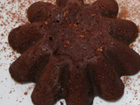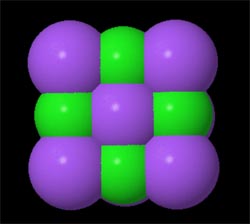Why is Chocolate Tempered?
Chocolate may be solid at room temperature and liquid at body temperature. However cocoa butter is polymorphic and can crystallize into six crystal forms with different physical characteristics
Cocoa butter can crystallize into six polymorphic forms designated as I–VI according to their stability and different physical characteristics such as gloss, hardness, and melting point (See Table below). The chemical composition is identical in all forms; only the arrangement of the lipid molecules varies.
| Crystal | Melting temp. | Formation Conditions | Chocolate Properties |
|---|---|---|---|
| I | 17 °C (63 °F) | Rapid cooling of the melt - | -Soft, crumbly, melts too easily |
| II | 21 °C (70 F) | Rapid cooling of the melt at 2oC/min | -- Soft, crumbly, melts too easily |
| III | 26 °C (79 °F) | Cyrstallization of the melt 5-10oC converts to II - | Firm, poor snap, melts too easily |
| IV | 28 °C (82 °F) | Crystallization at 16-21oC | Firm, good snap, melts too easily |
| V | 34 °C (93 °F) | Slow Crystallization of the melt | Glossy, firm, best snap, melts near body temperature (37 °C) |
| VI | 36 °C (97 °F) | From form V after several months at RT | Hard, takes weeks to form |
| Note: The most thermodynamically stable form, VI, has a dull surface and soft texture; only form V shows the hardness and glossy surface appreciated by the consumer. Chocolate lovers only accept chocolate in its crystal form V, since it has surface sheen, best snap and the pleasant melting sensation in the mouth. | |||
In order to make the chocolate crystallize exclusively to form V, the crystallization process has to be controlled by a sophisticated temperature process know as tempering.
Tempering chocolate consists of heating the chocolate to a certain temperature, cooling it to a certain temperature, and then heating it again to a certain temperature.
Tempering
Uncontrolled crystallization of cocoa butter typically results in crystals of varying size, some or all large enough to be clearly seen with the naked eye. This causes the surface of the chocolate to appear mottled and matte, and causes the chocolate to crumble rather than snap when broken. The uniform sheen and crisp bite of properly processed chocolate are the result of consistently small cocoa butter crystals produced by the tempering process.
The fats in cocoa butter can crystallize in six different crystal forms. The primary purpose of tempering is to assure that only the best form is present. The six different crystal forms have different properties.
As a solid piece of chocolate, the cocoa butter fat particles are in a crystalline rigid structure that gives the chocolate its solid appearance. Once heated, the crystals of the polymorphic cocoa butter are able to break apart from the rigid structure and allow the chocolate to obtain a more fluid consistency as the temperature increases – the melting process. When the heat is removed, the cocoa butter crystals become rigid again and come closer together, allowing the chocolate to solidify.
The temperature in which the crystals obtain enough energy to break apart from their rigid conformation would depend on the milk fat content in the chocolate and the shape of the fat molecules, as well as the form of the cocoa butter fat. Chocolate with a higher fat content will melt at a lower temperature.
Making chocolate considered "good" is about forming as many type V crystals as possible. This provides the best appearance and texture and creates the most stable crystals, so the texture and appearance will not degrade over time. To accomplish this, the temperature is carefully manipulated during the crystallization.
The tempering process--
Generally, the chocolate is first heated to 50 °C to melt all six forms of crystals.
Next, the chocolate is cooled to about 27 °C, for a few minutes which will allow crystal types IV and V to form. At this temperature, the chocolate is agitated to create many small crystal "seeds" which will serve as nuclei to create small crystals in the chocolate.
The chocolate is then heated to about 31 °C to eliminate any type IV crystals, leaving just type V. After this point, any excessive heating of the chocolate will destroy the temper and this process will have to be repeated.
Other methods of chocolate tempering may also be used. The most common variant is introducing already tempered, solid "seed" chocolate. The temper of chocolate can be measured with a chocolate temper meter to ensure accuracy and consistency. A sample cup is filled with the chocolate and placed in the unit which then displays or prints the results.
Two classic ways of manually tempering chocolate are:
- Working the molten chocolate on a heat-absorbing surface, such as a stone slab, until thickening indicates the presence of sufficient crystal "seeds"; the chocolate is then gently warmed to working temperature.
- Stirring solid chocolate into molten chocolate to "inoculate" the liquid chocolate with crystals (this method uses the already formed crystals of the solid chocolate to "seed" the molten chocolate).
Chocolate tempering machines (or temperers) with computer controls can be used for producing consistently tempered chocolate, particularly for large volume applications.
Using a Sous Vide Machine to temper chocolate:
If one has a sous vide machine it is possible to temper chocolate relatively easy. Sous vide Supreme which sells the product gives details
Notes:
Crystal form V is less stable than VI since there is relatively loose packing of the lipid molecules, leaving empty spaces. In the solid state, crystal form V also tends to convert into the more stable form VI. The addition of milk fat will retard the conversion. This is the reason that the V→VI transition is less often observed in milk chocolate.
Articles and References
Chocolate – The Noblest Polymorphism II
The Food Lab -- The Best Way to Temper Chocolate
Guittard -- from bean to bar -- The Art of Chocolate Making
|
Science of Chocolate

What are the health benefits of Chocolate?
What are the drugs in Chocolate?
Research on Chocolate and Cocoa
Who makes the best Chocolate in the World?
Related Coffee Sites
See also:
Chemical compounds in coffee that produce aroma and bitterness
Science behind pulling the perfect espresso shot
Science of Cooking
See also:
